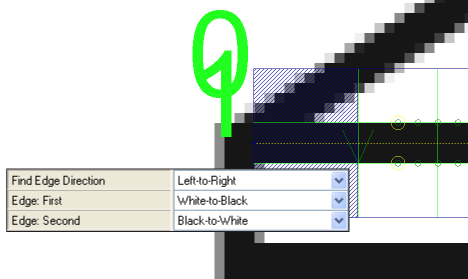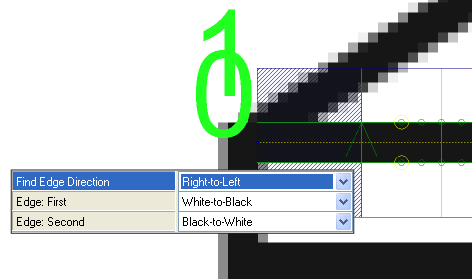InspectEdgePosition
The InspectEdgePosition function is used to construct an edge model to perform advanced edge analysis on the edges returned by an InspectEdge function. This data is used determine the location of edges, identifying outlier edges, and optionally constructing a line fit.
InspectEdgePosition Overview
After inserting the function into the spreadsheet, a reference must be made to an Inspect data structure output by an InspectEdge function. Once the reference to the InspectEdge function has been established, the edge model is created by configuring the parameters of the InspectEdgePosition function. The edge model involves defining the following:
- The type of line fit - straight or circular.
- The direction in which to detect edges.
- The type of edge transition - white to black or vice-versa.
- The edge scoring criteria that will be used to filter unwanted edges.
- The line fit criteria that will be used to filter unwanted edges from the line fit.
Once the edge model has been established, the function will compare edge candidates against the edge model and report deviations from the model.
InspectEdgePosition Inputs
| Parameter | Description | ||||||||||||||||||||||
|
InspectEdge |
Specifies a reference to a spreadsheet cell that contains a valid Inspect data structure returned by an InspectEdge function. | ||||||||||||||||||||||
|
Line Fit |
Specifies the type of line fit to be constructed out of the detected edges.
|
||||||||||||||||||||||
|
Find Edge Direction |
Specifies the direction in which the function will attempt to detect edges. Dark green arrows are added to graphically illustrate the direction in which the edge will be detected. Fit lines will be labeled graphically within the image, with the first fit line being labeled 0, and the second fit line being 1. Note: If the region of interest (ROI) of the referenced InspectEdge function is bent into a curve, the inspection will be relative to the curve’s center. When the Find Edge Direction parameter is set to Left-to-Right, it inspects towards the curve’s center, and when set to Right-to-Left, it inspects away from the curve’s center.
|
||||||||||||||||||||||
|
Edge: First |
Specifies the contrast transition of the first edge to be detected, as determined by the Find Edge Direction parameter.
|
||||||||||||||||||||||
|
Edge Scoring |
Specifies the edge scoring mode that will be used to determine whether or not an edge meets the established criteria.
|
||||||||||||||||||||||
|
Advanced Line Fit |
Specifies how the function should construct the line fit.
|
||||||||||||||||||||||
|
Caliper Index |
Specifies the Caliper to be displayed on the image (the Caliper will be outlined in green); default Caliper displayed is 0. |
||||||||||||||||||||||
|
Show |
Specifies the display mode for InspectEdgePosition graphical overlays on top of the image.
|
InspectEdgePosition Outputs
|
Returns |
An Inspect data structure containing the matching edges sorted by score, or #ERR if any of the input parameters are invalid. |
|||||||||||||||||||||||||||||||||
|
Results |
When InspectEdgePosition is initially inserted into a cell, a results table is created in the spreadsheet using the following InspectEdge Vision Data Access Functions The InspectEdgePosition data structure result table, which is broken into two sections, Furthest Points and Straight Line Fit:
All of the formulas for the InspectEdgePosition conform to the following: Note:
|
|||||||||||||||||||||||||||||||||

